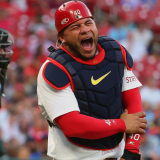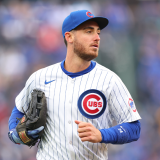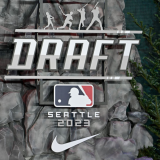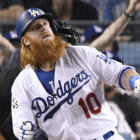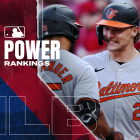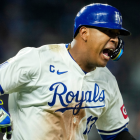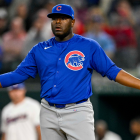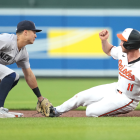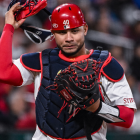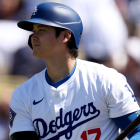LOS ANGELES -- A game of baseball -- such as the one the Dodgers won on Tuesday night against the Astros (LAD 3, HOU 1) -- is never reducible to a single moment. However, there are moments that tilt the scales heavily toward victory or defeat. One such moment in Game 1 of the 2017 World Series came in the sixth inning, when Justin Turner of the Dodgers stepped against Houston's Dallas Keuchel with one on, two out, and the score tied at one.
You likely know how the encounter ended, but let's take a moment to appreciate the trends and decisions that went into it. Baseball's a game of layers, you know, and how each layer comes into being affects the ones that come after. This moment was no exception ...
The splits
Turner of course had the platoon advantage in this one, and Keuchel is indeed vulnerable against the opposite side. For his career, he's allowed an OPS of .588 to left-handed batters but an OPS of .715 against right-handed batters. Against lefties, his career K/BB ratio is 4.91, but against righties that figure tumbles to 2.39.
As for Turner, the match-up was also in his "handedness" wheelhouse ...
Justin Turner had an OPS of 1.181 (172 PAs) versus LHP this season (Rank: 3rd of 145 full-time hitters in MLB; League Avg: .745).
— Inside Edge (@InsideEdgeScout) October 25, 2017
A lot of times, we make too much of splits, but the traditional lefty-righty platoon splits are a real thing. As such, Houston manager A.J. Hinch had to make a choice.
The decision
When Turner came up following Chris Taylor's walk, Keuchel was just 68 pitches. He was, however, into his third time through the batting order, and it's pointed out ad nauseam that starting pitchers tend to see significant decline when they face a lineup for the third time in a given start. So that in addition to the platoon issues were working against Keuchel. Keuchel, though, is one of two Houston aces, and it's reasonable to treat aces a bit differently than more garden-variety hurlers. On those grounds, sticking with Keuchel wasn't unusual or indefensible.
Keuchel wound up working 6 2/3, and it wasn't until the Astros were batting in the top of the seventh that Hinch ordered Brad Peacock to warm up. Keuchel retired lefty-on-lefty Cody Bellinger to end the sixth, and then in the bottom of the seventh he faced three straight right-handers before Peacock came in. Maybe Peacock, as a primary starter, takes a bit longer to warm up, but Hinch seemed in no hurry to lift Keuchel, even with Yasiel Puig, Enrique Hernandez, and Corey Seager batting.
There's also the matter of how little trust Hinch has shown in a certain trio of right-handed relievers. In the ALCS, Will Harris, Chris Devenski, and Joe Musgrove combined for just 2 2/3 innings. That's despite their being some of the Astros' best middle relievers during the regular season (Musgrove was dominant after going from the rotation to the bullpen in July). Because of some small-sample playoff struggles, though, Hinch has moved away from them. Devenski faced three batters in Game 1, but that was after Keuchel and Peacock. Maybe that lack of confidence in those right-handed relievers played a role in Hinch's letting Keuchel face Turner, even after Taylor drew that five-pitch walk.
The pitches
So Keuchel against the right-handed Turner it was. Keuchel is of course a sinker-first pitcher, but that's a pitch that tends not to play well against the opposite side. That's why Keuchel, despite throwing the pitch more than 70 percent of the time against lefties tamps that down to less than half the time against righty bats like Turner. He also throws the slider less against the opposite side, which is standard stuff. To replace those sloughed off sinkers and sliders, Keuchel throws a changeup and cutter to right-handers (he almost never throws those two pitches to same-side bats).
So with that scouting report out of the way, here's how he attacked Turner in the sixth inning ...
- Ball 1: 87 mph cutter, down and in.
- Strike 1, swinging: 87 mph cutter, down and in.
- Strike 2, called: 90 mph sinker, low and away (should've been a ball).
- Home run: 87 mph cutter, up and in.
So we've got three cutters mixed in with a sinker and a pair of pickoff attempts. Of the 14 pitches that Keuchel threw to Turner in Game 1, 12 were either sinkers or cutters -- i.e., hard stuff. Otherwise, he threw a slider to him in the first and a slider to him in the fourth. Given all the 87-90 mph offerings that Turner saw from Keuchel on Tuesday, maybe the fourth pitch of the sequence above should've been the first changeup that Turner saw all night. But that's not what happened.
The location
Earlier in the game, Keuchel had tried to pitch Turner down and in on a couple of occasions and missed high. Well, that's what happened on the pitch that Turner drove out to left ...
Where Keuchel wanted the pitch and where he put it.
— Pitcher List (@ThePitcherList) October 25, 2017
Good on Justin Turner for taking advantage of another Dallas Keuchel mistake pic.twitter.com/R6fh8dspOn
Brian McCann wanted it knee level and off the plate, but instead Keuchel's cutter leaked over the inside corner and came in above Turner's belt. As mentioned, Keuchel did this twice earlier in the game and got away with it. This time, though, was different.
The swing
Turner was a little late on those earlier two pitches with which Keuchel missed high. So how do you speed up your bat? One way is to swing a lighter bat. Speaking of which, here's what Turner said after Game 1 ...
"My first two at-bats I was swinging a little bit bigger bat, a 34 and a half. And I got beat in a couple of times. So I'm going to switch back to my 33 and a half that I normally use, a little smaller bat. Good thing I did, because I didn't get beat in the third time."
No, he indeed did not get beat ...
The carry
Turner, as the story goes, changed his swing late in his Mets career at the urging of Marlon Byrd. He focused on driving the ball in the air, on elevating, and Turner went from a fringe utility guy to an offensive force for the best team in baseball. This one, though, wasn't Turner's best ball ...
Thank you, hot air. Balls hit like Turner's (96 mph, 37 degrees) don't go for HR very often. pic.twitter.com/ZroevtskQM
— Andrew Simon (@AndrewSimonMLB) October 25, 2017
He got under it a bit, but it went out nonetheless. That's probably in part because the official temp in Los Angeles at game time was 103 degrees. "I didn't know if it was going to be a home run or not," Turner said after the game. "I knew I back spun it pretty good. I knew I hit it really high. And I knew it was about 98 degrees. So when it's that hot here, the ball does travel a lot better. And I think I just said it outside, if it's ten degrees cooler, that's probably a routine fly ball in left field."
Yes, Keuchel missed his spot, but he didn't necessarily deserve that outcome. But as Mr. Eastwood would hasten to remind you ...
The fallout
When Turner stepped in, the Dodgers had a 53.4 percent chance of winning Game 1 -- i.e., coin-flip territory. Four pitches and one unlikely home run later, the Dodgers' chances of prevailing had jumped to 84 percent. That eventual win for the Dodgers, as noted in this space, gives them in historical terms a two-in-three chance of winning the World Series.
Yes, if Justin Verlander twirls in vintage fashion in Game 2, then we'll likely be evened up heading back to Houston. For now, though, Turner's home run off that misplaced Keuchel cutter stands as the needle-moving moment of the 2017 World Series. If the Dodgers barge onward, we may still think of it as such.








